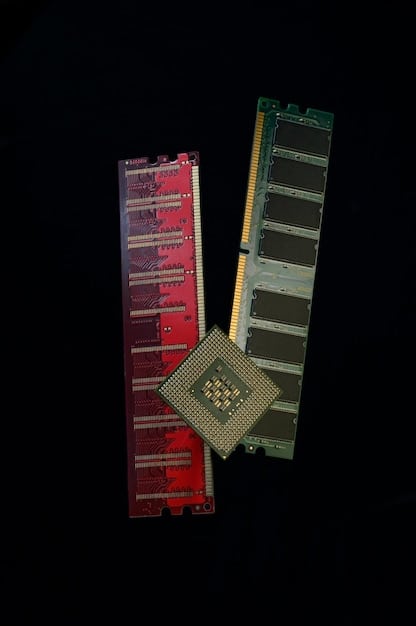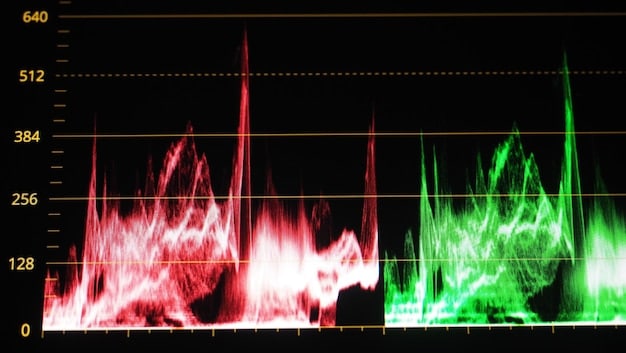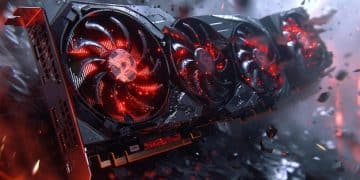AMD RX 7900 XTX vs RTX 4080: 4K Gaming Showdown in 2025

In 2025, the AMD Radeon RX 7900 XTX and NVIDIA RTX 4080 remain top contenders for 4K gaming, offering high performance, but factors like price, features, and game optimizations will determine the best choice for gamers.
Choosing the right graphics card for 4K gaming in 2025 means understanding the strengths and weaknesses of leading contenders. The AMD Radeon RX 7900 XTX vs. NVIDIA RTX 4080: A Data-Driven Comparison for 4K Gaming in 2025 helps gamers make an informed decision.
Performance Overview: RX 7900 XTX and RTX 4080
In the landscape of high-end graphics cards, both the AMD Radeon RX 7900 XTX and NVIDIA GeForce RTX 4080 stand out as powerful options for gamers looking to experience 4K gaming at its finest. Understanding their performance profiles is crucial for making an informed decision.
Raw Performance Metrics
The RX 7900 XTX often trades blows with the RTX 4080 in rasterization performance, sometimes edging ahead in titles that favor AMD’s architecture. However, the RTX 4080 typically demonstrates superior ray tracing capabilities, thanks to NVIDIA’s more mature RT cores.
DLSS vs. FSR
NVIDIA’s Deep Learning Super Sampling (DLSS) and AMD’s FidelityFX Super Resolution (FSR) are upscaling technologies that significantly impact performance. While DLSS has traditionally been considered the gold standard, FSR has made strides in image quality and adoption. Let’s see the main differences:
- DLSS (Deep Learning Super Sampling): NVIDIA’s proprietary technology uses AI and machine learning to render games at a lower resolution and then upscale them to a higher resolution, like 4K. This results in improved frame rates with minimal loss in visual fidelity.
- FSR (FidelityFX Super Resolution): AMD’s open-source technology aims to achieve similar results to DLSS but is compatible with a wider range of GPUs. FSR has evolved, with newer versions focusing on enhancing image quality to better compete with DLSS.
Ultimately, the choice between these cards often depends on the specific games and features that matter most to individual users. Both the RX 7900 XTX and RTX 4080 deliver exceptional 4K gaming experiences, but their strengths lie in different areas.

Architecture and Specifications Compared
Delving into the technical specifications of the AMD Radeon RX 7900 XTX and NVIDIA GeForce RTX 4080 provides crucial insights into their capabilities and potential performance. Understanding the architecture and specifications of these cards allows you to make the best choice for your setups.
AMD Radeon RX 7900 XTX
Built on the RDNA 3 architecture, the RX 7900 XTX features a chiplet design, combining a graphics compute die (GCD) with multiple memory cache dies (MCDs). This approach enhances memory bandwidth and efficiency.
NVIDIA GeForce RTX 4080
The RTX 4080 is based on the Ada Lovelace architecture, featuring enhanced RT Cores, Tensor Cores, and Streaming Multiprocessors. This architecture prioritizes ray tracing and AI-driven tasks. Let’s check a list about it:
- CUDA Cores: Essential for parallel processing in gaming and professional applications.
- RT Cores: Dedicated hardware for accelerating ray tracing tasks.
- Tensor Cores: Accelerate AI and machine learning tasks, notably DLSS.
When evaluating the RX 7900 XTX and RTX 4080, consider the importance of specific features like ray tracing, DLSS, and raw compute power. The RX 7900 XTX offers a compelling package with its innovative architecture and high memory bandwidth, while the RTX 4080 excels in ray tracing and AI-accelerated tasks.
Ray Tracing and Upscaling Technologies
Ray tracing and upscaling technologies are pivotal in modern gaming, enhancing visual fidelity while maintaining acceptable frame rates. The AMD Radeon RX 7900 XTX and NVIDIA GeForce RTX 4080 take distinct approaches to these features.
Ray tracing simulates the behavior of light, creating more realistic reflections, shadows, and global illumination.
DLSS Deep Dive
DLSS leverages AI to render frames at a lower resolution and then upscale them, resulting in significant performance gains with minimal visual impact. New versions of DLSS have made it even better!
FSR in Detail
FSR is an open-source technology that aims to provide similar upscaling benefits to DLSS, but with broader compatibility across different GPUs and platforms. We can list some features of FSR to better explore its functionality:
- Spatial Upscaling: Uses algorithms to upscale frames without relying on AI.
- Temporal Upscaling: Incorporates data from previous frames to improve image quality.
- Sharpening Filters: Enhances clarity and detail in upscaled images.
In summary, both the RX 7900 XTX and RTX 4080 offer compelling solutions for ray tracing and upscaling, each with its own strengths and trade-offs. The choice between them depends on the specific games you play and your preferences regarding image quality, performance, and compatibility.

Pricing and Value: A 2025 Perspective
Pricing and overall value are critical factors when selecting a graphics card, especially when considering the long-term investment. Both the AMD Radeon RX 7900 XTX and NVIDIA GeForce RTX 4080 occupy the higher end of the market, but their relative value propositions can vary depending on market conditions and individual needs.
Initial Cost Analysis
The initial cost of a graphics card is often the primary consideration for many buyers. Historically, AMD cards have sometimes offered a more competitive price-to-performance ratio compared to their NVIDIA counterparts, but this can fluctuate.
Long-Term Cost of Ownership
Beyond the initial purchase price, consider factors that can impact the long-term cost of ownership. Power consumption is one such factor, as higher power draw can lead to increased electricity bills. One must verify factors like:
- Power Consumption: Check the typical power consumption under load.
- Cooling Solutions: Evaluate the effectiveness of the card’s cooling system.
- Driver Support: Assess the quality and frequency of driver updates.
Ultimately, the decision between the RX 7900 XTX and RTX 4080 should be based on a holistic assessment of your gaming preferences, budget, and long-term needs. Consider the specific games you play, the importance of features like ray tracing and DLSS, and your tolerance for power consumption.
The Gaming Experience: 4K and Beyond
The ultimate measure of a graphics card lies in the gaming experience it delivers. For 4K gaming in 2025, both the AMD Radeon RX 7900 XTX and NVIDIA GeForce RTX 4080 are capable of providing smooth, immersive, and visually stunning gameplay.
4K Performance Benchmarks
In most modern titles, both cards can deliver frame rates exceeding 60 fps at maximum settings, providing a fluid and responsive gaming experience. However, performance can vary significantly depending on the specific game and settings used.
VR Gaming
Virtual Reality (VR) gaming places even greater demands on a graphics card, requiring sustained high frame rates and low latency. Both the RX 7900 XTX and RTX 4080 are well-equipped to handle VR titles, but their performance characteristics may differ. The critical aspects are generally associated with:
- High Frame Rates: Maintaining a consistent 90+ fps for smooth VR experiences.
- Low Latency: Minimizing input lag to avoid motion sickness.
- VR Features: Supporting VR-specific features like variable rate shading.
When assessing the gaming capabilities of the RX 7900 XTX and RTX 4080, consider the specific games you play, your display technology, and your preferences for visual settings. Both cards offer exceptional 4K gaming experiences, but their strengths may align better with certain titles or hardware configurations.
Future-Proofing Your Gaming Rig
Investing in a high-end graphics card like the AMD Radeon RX 7900 XTX or NVIDIA GeForce RTX 4080 is not just about current performance; it’s also about future-proofing your gaming rig for the years to come. As game technology advances and new titles push the boundaries of visual fidelity, having a capable GPU becomes increasingly important.
Emerging Technologies
Several emerging technologies and trends are poised to shape the future of gaming. One notable example is the continued evolution of ray tracing. As game developers become more adept at implementing ray-traced effects, the performance gap between cards with strong ray tracing capabilities and those without may widen.
Software and Driver Support
Long-term software and driver support is another critical factor to consider when future-proofing your gaming rig. AMD and NVIDIA both have a track record of providing regular driver updates that optimize performance, fix bugs, and introduce new features. When choosing, keep in mind to check:
- Driver Stability: Look for consistent and reliable driver releases.
- Feature Updates: Assess the frequency of new feature additions.
- Community Feedback: Monitor user reviews and forums for insights.
In conclusion, selecting a graphics card for the long haul requires careful consideration of future gaming trends, emerging technologies, and software support. While both the RX 7900 XTX and RTX 4080 are formidable options today, their suitability for future titles will depend on their ability to adapt to evolving gaming demands.
| Key Aspect | Brief Description |
|---|---|
| 🚀 Raw Performance | RX 7900 XTX and RTX 4080 trade blows, with the AMD card sometimes edging ahead in rasterization. |
| 💡 Ray Tracing | RTX 4080 typically demonstrates superior ray tracing performance. |
| ⚖️ DLSS vs. FSR | DLSS is NVIDIA’s proprietary AI-driven upscaling, while FSR is AMD’s open-source alternative. |
| 💰 Pricing | AMD cards have sometimes offered a more competitive price-to-performance ratio. |
Frequently Asked Questions
▼
The AMD Radeon RX 7900 XTX often matches or slightly exceeds the NVIDIA GeForce RTX 4080 in traditional rasterization tasks, but the performance depends on the specific game and settings.
▼
DLSS (NVIDIA) uses AI for superior upscaling and image quality, while FSR (AMD) is open-source and compatible with more GPUs, providing a balance of performance and visuals.
▼
The NVIDIA GeForce RTX 4080 typically offers better ray tracing performance due to its dedicated RT cores and more mature ray tracing technology.
▼
Both cards require substantial power, but it’s essential to check the exact power consumption under load, as power draw can impact electricity bills and cooling needs over time.
▼
The long-term investment depends on individual gaming preferences, the importance of ray tracing, and software support. Both cards are excellent but cater to slightly different needs.
Conclusion
Choosing between the AMD Radeon RX 7900 XTX and NVIDIA GeForce RTX 4080 for 4K gaming in 2025 depends on your priorities. The RX 7900 XTX offers competitive rasterization performance and value, while the RTX 4080 excels in ray tracing and DLSS. Assess your gaming needs to make the right choice.





